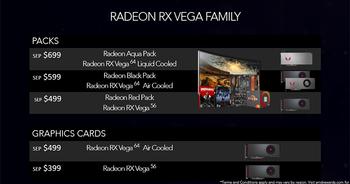It's full-steam ahead at AMD. The firm's CPU division has turned a corner, and then some, and the recently formed Radeon Technologies Group (RTG) is now gearing up to re-establish AMD as a competitive force in the discrete desktop GPU market.
RTG's hopes rest on the shoulders of two new products based on the latest-generation Vega architecture; Radeon RX Vega 64, priced from $499; and Radeon RX Vega 56, from $399.
Raja Koduri, RTG senior vice president and chief architect, took to the stage in Los Angeles, California, to introduce the long-awaited graphics cards with an emphasis on the overall capability of AMD's modernised ecosystem.
Confirming that Radeon RX Vega will not be a trailblazer in its initial form, the focus instead shifts to user experience, with AMD shedding light on an architecture suited to larger environments and more detailed worlds, optimised drivers, a wide range of FreeSync displays and, now, GPUs capable of meeting the preferred 48Hz - 100Hz FreeSync range.
Vega, it seems, is here to drive gamers into the FreeSync ecosystem, and AMD is hoping to tempt consumers with incentivised bundles known as Radeon Packs. As part of the promotion, customers purchasing a Radeon RX Vega Pack will be able to claim up to $200 off a 34in Samsung CF791 FreeSync-enabled monitor, $100 off a Ryzen 7 CPU and X370 motherboard combo, and two free games worth up to $120.
This deviation from performance to experience has resulted in two Radeon RX Vega GPUs being made available in a choice of five flavours, ranging from the $699 Radeon Aqua Pack complete with liquid-cooled RX Vega 64, to the standalone air-cooled Radeon RX Vega 56 at $399.
Such is the focus on smooth FreeSync gameplay that RX Vega 64's specification became merely a footnote in Koduri's presentation. For the record, the faster of the two air-cooled cards is equipped with 4,096 stream processors clocked at 1,247MHz base and 1,546MHz boost, alongside 8GB of HBM2 memory offering 484GB/s of bandwidth.
AMD Radeon RX Vega Specifications |
|||
|---|---|---|---|
| Model | Radeon RX Vega 64 Liquid Cooled Edition |
Radeon RX Vega 64 |
Radeon RX Vega 56 |
| Vega 10 Compute Units | 64 |
64 |
56 |
| Stream Processors | 4,096 |
4,096 |
3,584 |
| Base Clock | 1,406MHz |
1,247MHz |
1,156MHz |
| Boost Clock | 1,677MHz |
1,546MHz |
1,471MHz |
| Memory Bandwidth | 484GB/s |
484GB/s |
410GB/s |
| Peak SP Performance | 13.7 TFLOPS |
12.7 TFLOPS |
10.5 TFLOPS |
| High Bandwidth Cache (HMB2) | 8GB |
8GB |
8GB |
| TDP | 345W |
295W |
210W |
| MSRP | $699 |
$499 |
$399 |
RX Vega 64 is said to offer real-world framerates comparable to that of a GeForce GTX 1080, while RX Vega 56 is positioned to compete with the GeForce GTX 1070 launched way back in May 2016. AMD fans hoping for more raw speed may be left wanting, yet RX Vega serves as a significant upgrade from previous-generation Radeon parts, and for those who have been contemplating a FreeSync display, there's now a choice of suitable GPUs.
In addition to the two air-cooled models, AMD will also make available an RX Vega 64 Liquid Cooled Edition, whose heightened power target results in an eight per cent performance increase at 345W. At the opposite end of the scale, a smaller Radeon RX Vega Nano will follow, offering mini-ITX performance at a lower TDP. Custom-cooled partner cards sadly won't be available until Q4 of this year.
Complicating matters, not all reference models will be available as a standalone card. The entry-level $399 and $499 variants of RX Vega 56 and RX Vega 64 will be the only standalone options, with both employing a familiar all-black Radeon cooler. A Radeon RX Vega 64 Limited Edition Pack will offer solid metal construction at a cost of $599 while supplies last, and the liquid-cooled option can only be purchased as part of a $699 pack.
Digging deeper into architecture ahead of upcoming reviews, AMD confirmed that Vega 10 die features 12.5 billion transistors on a 14nm FinFET LPP process, utilises an Infinity Fabric interconnect and employs HBM2 memory touting a 75 per cent smaller footprint than GDDR5 and a 2x increase in bandwidth per pin compared to HBM1.
AMD's next-gen compute unit touts enhanced SIMD with rapid-packed math, double the effective register space, improved L2 cache, double the peak floating rate with 16-bit ops and 40 new instructions added to the ISA. A primitive shader sat between surface shader and rasteriser also hopes to increase efficiency, while a forward-looking high-bandwidth cache controller (HBCC) promises real-time access to massive data sets.
Add to the mix a trusted memory zone for moving encrypted data in a protected way, a display engine that supports 4K at 120Hz with HDR and the most complete implementation of the DX12 and Vulkan APIs to date, and it is clear that Vega is a significant milestone for the Radeon Technologies Group. The foundation has been laid, but where Vega goes from here will depend heavily on developer support and market penetration. Realistic in its appraisal of Vega as it stands today, AMD's most pertinent description of next-generation Radeon hardware is simply "great performance today, more to come."












